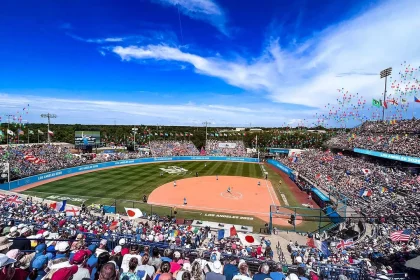Why is Basketball Popular in the Global Sports Market?
Basketball’s global popularity is driven by several factors:
Contents
- Universal Accessibility: Requiring minimal equipment (a ball and hoop), basketball is played in over 200 countries, from urban courts to professional arenas, appealing to diverse ages and skill levels.
- Star Power and Cultural Impact: NBA stars like LeBron James, Stephen Curry, and Giannis Antetokounmpo, alongside WNBA icons like Breanna Stewart, captivate fans worldwide. Basketball’s influence in music, fashion (e.g., sneaker culture), and media amplifies its reach.
- Global Reach: The NBA, valued at $108 billion in 2024, broadcasts to 215 countries, while leagues in Europe, China, and Australia expand the sport’s footprint. Social media engagement (e.g., NBA’s 80 million X followers) fuels fan interaction.
- Economic Impact: Basketball contributes significantly to the $614 billion global sports market (2025) through ticket sales, sponsorships ($150 billion in 2025), and merchandise. The sneaker market alone, tied to basketball, is worth $90 billion.
- Olympic and International Appeal: As a Summer Olympic sport since 1936 (men) and 1976 (women), basketball draws massive viewership. Its fast-paced, high-scoring nature aligns with global demand for dynamic sports.
- Technological Innovation: Wearables, AI analytics, and apps like HomeCourt enhance training and fan engagement, tying into the $18.85 billion sports tech market (2024).
Important Global Events
Basketball features a robust calendar of prestigious competitions:
- Summer Olympic Games: Held every four years (next: Los Angeles 2028), featuring men’s and women’s 5×5 and 3×3 tournaments.
- FIBA Basketball World Cup: Every four years (next: 2027, Qatar), the premier international competition for national teams.
- NBA Finals: Annual championship of the National Basketball Association (June), crowning the world’s top professional team.
- WNBA Finals: Annual women’s professional championship (September–October).
- EuroLeague Final Four: Europe’s top club competition, held annually in May.
- FIBA Continental Championships: Events like EuroBasket, AfroBasket, and Asia Cup, held every two years, qualify teams for global tournaments.
- NCAA March Madness: Annual U.S. college basketball tournament (March–April), a cultural phenomenon with global viewership.
- FIBA 3×3 World Cup: Annual event for the fast-paced 3×3 format, growing in popularity since its Olympic debut in 2020.
How to Get Started and Excel in Basketball
Aspiring basketball players, young or old, can follow these steps to begin and succeed:
Getting Started
- Learn the Basics: Join a local basketball program (school, community center, or YMCA) to master dribbling, shooting, passing, and basic rules. Many programs cater to beginners of all ages.
- Join a Team or Club: Affiliate with a school team, AAU (Amateur Athletic Union) club, or local league for structured coaching and competition. National bodies like USA Basketball or Basketball Australia offer resources.
- Acquire Equipment: Purchase a basketball ($20–$50, size 7 for men, size 6 for women/youth) and court-appropriate shoes ($50–$150). Access to a hoop (public court or home setup) is essential.
- Find a Coach: Work with a certified coach (e.g., through USA Basketball or FIBA programs) to develop fundamentals like shooting form and defensive stance.
- Play Regularly: Participate in pickup games, camps, or recreational leagues to build skills and confidence.
Path to Excellence
- Commit to Training: Dedicate 4–6 days/week to on-court practice, physical conditioning, and mental preparation. Consistency is critical for skill development.
- Leverage Technology: Use video analysis (e.g., Hudl) to refine shooting or defensive technique and bitwearables (e.g., Fit) to track fitness. Apps like HomeCourt provide AI-driven drills.
- Compete Progressively: Advance from local leagues to regional, national, and international tournaments (e.g., AAU, FIBA youth events). Early competition builds game IQ and resilience.
- Pursue Advanced Coaching: Attend basketball camps (e.g., Nike Basketball Camps, Five-Star) or academies (e.g., IMG Academy) for elite training. Work with specialized coaches for position-specific skills (e.g., point guard play).
- Balance Commitments: Young athletes should integrate academics with training, while older athletes can manage work or family to avoid burnout.
- Focus on Recovery: Prioritize nutrition, sleep (7–9 hours), and injury prevention (e.g., ankle bracing, load management) to sustain performance.
In summary, basketball’s popularity in the global sports market is driven by its simplicity, accessibility, global icons, strong media presence, and cultural influence. The NBA’s efforts to promote the sport internationally, along with the game’s exciting and dynamic nature, have made basketball one of the most popular and widely played sports in the world.


















